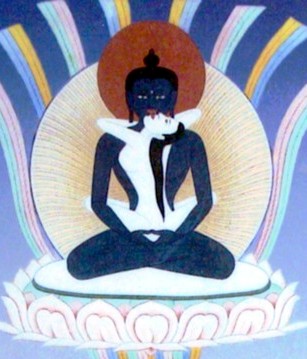Samantabhadra: Difference between revisions
No edit summary |
No edit summary |
||
| Line 4: | Line 4: | ||
1) In the [[Dzogchen]] teachings, our true nature, that state of the [[Ground]], is given the name the 'Primordial Buddha'. He is depicted as a [[buddha]], sky-blue in colour, sitting in the vast expanse of space, and encircled by an aura of rainbow light. He is completely naked, meaning unstained by any trace of concept. His name, Kuntuzangpo in Tibetan, Samantabhadra in Sanskrit, means ‘always good', ‘always well’ or ‘unchanging goodness.’ What this signifies is that unchanging goodness, or fundamental goodness, is our ultimate nature. | 1) In the [[Dzogchen]] teachings, our true nature, that state of the [[Ground]], is given the name the 'Primordial Buddha'. He is depicted as a [[buddha]], sky-blue in colour, sitting in the vast expanse of space, and encircled by an aura of rainbow light. He is completely naked, meaning unstained by any trace of concept. His name, Kuntuzangpo in Tibetan, Samantabhadra in Sanskrit, means ‘always good', ‘always well’ or ‘unchanging goodness.’ What this signifies is that unchanging goodness, or fundamental goodness, is our ultimate nature. | ||
2) One of the [[eight great bodhisattvas]], | 2) One of the [[eight great bodhisattvas]], renowned for the vastness of his offerings. He is depicted as reddish-green in colour, and holding a corn-ear of jewels as a sign that he fulfils the wishes of all beings. His story is recounted in the ''[[Gandavyuha Sutra]]'', which includes his famous prayer of aspiration, ''[[Samantabhadra's Aspiration to Good Actions]]''. | ||
==Further Reading== | ==Further Reading== | ||
Revision as of 16:48, 8 September 2009

Samantabhadra (Skt.; Tib. Kuntuzangpo; Wyl. kun tu bzang po) —
1) In the Dzogchen teachings, our true nature, that state of the Ground, is given the name the 'Primordial Buddha'. He is depicted as a buddha, sky-blue in colour, sitting in the vast expanse of space, and encircled by an aura of rainbow light. He is completely naked, meaning unstained by any trace of concept. His name, Kuntuzangpo in Tibetan, Samantabhadra in Sanskrit, means ‘always good', ‘always well’ or ‘unchanging goodness.’ What this signifies is that unchanging goodness, or fundamental goodness, is our ultimate nature.
2) One of the eight great bodhisattvas, renowned for the vastness of his offerings. He is depicted as reddish-green in colour, and holding a corn-ear of jewels as a sign that he fulfils the wishes of all beings. His story is recounted in the Gandavyuha Sutra, which includes his famous prayer of aspiration, Samantabhadra's Aspiration to Good Actions.
Further Reading
- Jamgön Mipham, A Garland of Jewels, (trans. by Lama Yeshe Gyamtso), Woodstock: KTD Publications, 2008